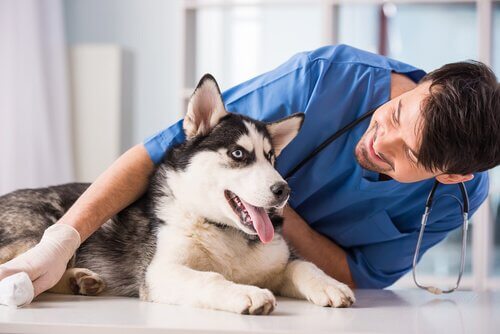Broken Bones: What To Do If Your Dog Breaks a Bone


Written and verified by the lawyer Francisco María García
Falls, bumps, and collisions are the most common causes of broken bones in dogs. However, not all fractures are the same. Sometimes, they are serious and can be fatal if the dog doesn’t receive treatment.
Guidelines for action for broken bones in dogs

If you have some knowledge of first aid, you can start to immobilize the injured area with a magazine or newspaper tied or bandaged around the affected limb. However, it’s essential to go to the veterinarian as soon as possible. Also, move the dog as little as possible during his transfer.
If you don’t know how to immobilize the area or you’re not sure because you only have limited knowledge, we recommend not attempting to splint the bone. This is primarily because you run the risk of further injuring the area.
In addition, fractures located below the knee in the joints are more likely to get worse if the dog is moved.
Also, be aware that your pet may become unconscious after breaking a bone. Therefore, if you have to move the animal, keep their head raised and don’t bend or compress their neck. You want to avoid them swallowing their tongue and keep airways open. In addition, you’ll reduce the danger of injuries to the neck area.
When you suspect broken bones or dislocations, the dog should be examined by the veterinarian. Also, you shouldn’t give the animal anything to eat or drink. Most likely, your dog will need to be anesthetized, whether for a simple revision or to operate in more serious cases.
Health emergency
It’s important to act quickly when bringing the dog to the vet. Even if the accident happens over the weekend or during a holiday, there are clinics that have emergency services and are open 24 hours a day.
Also, many centers have ambulances to collect injured animals. Even though the external fracture may be serious, there also may be internal injuries that could be even more serious.
According to specialists, fractures that occur in flat bones are usually easier to fix. However, breaks along long bones, like the femur or that break tissues, are more serious. There are even some that will require surgery or casts to immobilize the area for a month or more.
Preventing broken bones in dogs

The most effective way to prevent broken bones in dogs is to avoid accidents that cause trauma. There are places with more danger or potential risk, such as gutters, sewers, drains, etc., where accidents occur more frequently. Some animals have even fallen out of windows. There may also be animals who get their legs trapped, which can result in a fracture as they try to escape.
In addition, if you have a garden outside, you need to make sure that there are no places where your animal can accidentally get trapped. Also, if your dog likes to look out the window and is nervous, active, or a puppy, we recommend always keeping the windows closed. Alternatively, you can put up a barrier to prevent the animal from falling out.
Also, getting hit by cars is another significant source of broken bones in dogs. This is a huge potential danger to dogs. To avoid collisions, it’s important to always use a leash. In a field when you have your dog off-leash, always keep an eye on him. If your dog escapes, he could easily get hit by a passing car or fall into a dangerous area.
Cases of increased risk of fracture in dogs
- Broken bones in older dogs are more frequent. After 10 years, dogs are more at risk for breaking a bone. These fractures also take longer to heal. Insufficient calcium, due to age, makes the healing process take longer.
- Decalcification and osteoporosis. In these cases, bones are weaker and even a small fall could cause a fracture.
- Dynamic, active dogs and puppies. Especially when your furry friend is running around outside, it’s important to watch her well in case of a fall.
Falls, bumps, and collisions are the most common causes of broken bones in dogs. However, not all fractures are the same. Sometimes, they are serious and can be fatal if the dog doesn’t receive treatment.
Guidelines for action for broken bones in dogs

If you have some knowledge of first aid, you can start to immobilize the injured area with a magazine or newspaper tied or bandaged around the affected limb. However, it’s essential to go to the veterinarian as soon as possible. Also, move the dog as little as possible during his transfer.
If you don’t know how to immobilize the area or you’re not sure because you only have limited knowledge, we recommend not attempting to splint the bone. This is primarily because you run the risk of further injuring the area.
In addition, fractures located below the knee in the joints are more likely to get worse if the dog is moved.
Also, be aware that your pet may become unconscious after breaking a bone. Therefore, if you have to move the animal, keep their head raised and don’t bend or compress their neck. You want to avoid them swallowing their tongue and keep airways open. In addition, you’ll reduce the danger of injuries to the neck area.
When you suspect broken bones or dislocations, the dog should be examined by the veterinarian. Also, you shouldn’t give the animal anything to eat or drink. Most likely, your dog will need to be anesthetized, whether for a simple revision or to operate in more serious cases.
Health emergency
It’s important to act quickly when bringing the dog to the vet. Even if the accident happens over the weekend or during a holiday, there are clinics that have emergency services and are open 24 hours a day.
Also, many centers have ambulances to collect injured animals. Even though the external fracture may be serious, there also may be internal injuries that could be even more serious.
According to specialists, fractures that occur in flat bones are usually easier to fix. However, breaks along long bones, like the femur or that break tissues, are more serious. There are even some that will require surgery or casts to immobilize the area for a month or more.
Preventing broken bones in dogs

The most effective way to prevent broken bones in dogs is to avoid accidents that cause trauma. There are places with more danger or potential risk, such as gutters, sewers, drains, etc., where accidents occur more frequently. Some animals have even fallen out of windows. There may also be animals who get their legs trapped, which can result in a fracture as they try to escape.
In addition, if you have a garden outside, you need to make sure that there are no places where your animal can accidentally get trapped. Also, if your dog likes to look out the window and is nervous, active, or a puppy, we recommend always keeping the windows closed. Alternatively, you can put up a barrier to prevent the animal from falling out.
Also, getting hit by cars is another significant source of broken bones in dogs. This is a huge potential danger to dogs. To avoid collisions, it’s important to always use a leash. In a field when you have your dog off-leash, always keep an eye on him. If your dog escapes, he could easily get hit by a passing car or fall into a dangerous area.
Cases of increased risk of fracture in dogs
- Broken bones in older dogs are more frequent. After 10 years, dogs are more at risk for breaking a bone. These fractures also take longer to heal. Insufficient calcium, due to age, makes the healing process take longer.
- Decalcification and osteoporosis. In these cases, bones are weaker and even a small fall could cause a fracture.
- Dynamic, active dogs and puppies. Especially when your furry friend is running around outside, it’s important to watch her well in case of a fall.
This text is provided for informational purposes only and does not replace consultation with a professional. If in doubt, consult your specialist.








